Warming and Dimming: Interactive Impacts on Potential Summer Maize Yield in North China Plain
Abstract
1. Introduction
2. Materials and Methods
2.1. Study Area
2.2. Technique Description
2.2.1. Active Accumulated Temperature (ATT)
2.2.2. Solar Radiation
2.2.3. Maize Potential Light–Temperature Productivity (PTP)
2.2.4. Climate Trend
2.2.5. Mann–Kendall (MK) Test
2.2.6. The Contribution Rate
3. Results
3.1. ATT10 and Solar Radiation at the Decadal Scale
3.2. ATT10 and Solar Radiation at the Annual Scale
3.3. Variation and Cause Analysis of PTP
4. Discussion
4.1. Climate Warming and Dimming in the NCP
4.2. The Combining Impacts of Climate Warming and Dimming on the PTP
5. Conclusions
Author Contributions
Funding
Conflicts of Interest
References
- Intergovernmental Panel on Climate Change (IPCC). Climate Change 2014: Synthesis Report; IPCC: Geneva, Switzerland, 2015. [Google Scholar]
- Philander, S.G. Why global warming is a controversial issue. Science 2001, 294, 2105–2106. [Google Scholar] [CrossRef][Green Version]
- Trolle, D.; Nielsen, A.; Rolighed, J.; Thodsen, H.; Andersen, H.E. Projecting the future ecological state of lakes in Denmark in a 6 degree warming scenario. Clim. Res. 2015, 64, 55–72. [Google Scholar] [CrossRef]
- Wang, L.; Liu, B.; Henderson, M.; Shen, X.; Yang, L. Warming across decades and deciles: Minimum and maximum daily temperatures in China, 1955–2014. Int. J. Climatol. 2017, 38, 2325–2332. [Google Scholar] [CrossRef]
- Hu, Q.; Pan, X.; Shao, C.; Zhang, D.; Wang, X.; Wei, X. Distribution and variation of china agricultural heat resources in 1961–2010. Chin. J. Agrometeorol. 2014, 35, 119–127. [Google Scholar]
- Wild, M. Global dimming and brightening: A review. J. Geophys. Res. Atmos. 2009, 114. [Google Scholar] [CrossRef]
- Stanhill, G.; Cohen, S. Global dimming: A review of the evidence for a widespread and significant reduction in global radiation with discussion of its probable causes and possible agricultural consequences. Agric. For. Meteorol. 2001, 107, 255–278. [Google Scholar] [CrossRef]
- Liepert, B. Observed reductions of surface solar radiation at sites in the United States and worldwide from 1961 to 1990. Geophys. Res. Lett. 2002, 29, 61. [Google Scholar] [CrossRef]
- Alpert, P.; Kishcha, P.; Kaufman, Y.J.; Schwarzbard, R. Global dimming or local dimming?: Effect of urbanization on sunlight availability. Geophys. Res. Lett. 2005, 321, 317–330. [Google Scholar] [CrossRef]
- Ohvril, H.; Teral, H.; Neiman, L.; Kannel, M.; Uustare, M. Global gimming and brightening versus atmospheric column transparency, Europe 1906–2007. J. Geophys. Res. Atmos. 2009, 114, 1588–1593. [Google Scholar] [CrossRef]
- Wild, M.; Gilgen, H.; Roesch, A.; Ohmura, A.; Long, C.N. From dimming to brightening: Decadal changes in solar radiation at Earth’s surface. Science 2005, 308, 847–850. [Google Scholar] [CrossRef]
- Raichijk, C. Observed trends in sunshine duration over South America. Int. J. Climatol. 2012, 32, 669–680. [Google Scholar] [CrossRef]
- Dwyer, J.G.; Norris, J.R.; Ruckstuhl, C. Do climate models reproduce observed solar dimming and brightening over China and Japan? J. Geophys. Res. Atmos. 2010, 115. [Google Scholar] [CrossRef]
- Pinker, R.T.; Zhang, B.; Dutton, E.G. Do satellites detect trends in surface solar radiation? Science 2005, 308, 850–854. [Google Scholar] [CrossRef] [PubMed]
- Wang, Y.; Yang, Y. China’s dimming and brightening: Evidence, causes and hydrological implications. Ann. Geophys. 2014, 32, 41–55. [Google Scholar] [CrossRef]
- Salinger, M.J. Increasing Climate Variability and Change: Reducing the Vulnerability. In Increasing Climate Variability and Change; Springer: Dordrecht, The Netherlands, 2005. [Google Scholar]
- Tao, F.; Yokozawa, M.; Xu, Y.; Hayashi, Y.; Zhang, Z. Climate changes and trends in phenology and yields of field crops in China, 1981–2000. Agric. For. Meteorol. 2006, 138, 82–92. [Google Scholar] [CrossRef]
- Wang, X.; Chen, Y.; Sui, P.; Gao, W.; Qin, F. Emergy analysis of grain production systems on large-scale farms in the North China Plain based on LCA. Agric. Syst. 2014, 128, 66–78. [Google Scholar] [CrossRef]
- Wang, J. Increased yield potential of wheat-maize cropping system in the North China Plain by climate change adaptation. Clim. Chang. 2012, 113, 825–840. [Google Scholar] [CrossRef]
- Parry, M.L.; Rosenzweig, C.; Iglesias, A.; Livermore, M.; Fischer, G. Effects of climate change on global food production under SRES emissions and socio-economic scenarios. Golb. Environ. Chang. 2004, 14, 53–67. [Google Scholar] [CrossRef]
- Yang, J.; Liu, Q.; Yan, C.; Mei, X. Spatial and temporal variation of solar radiation in recent 48 years in North China. Acta Ecol. Sin. 2011, 31, 2748–2756. [Google Scholar]
- Huang, S.; Lv, L.; Zhu, J.; Li, Y.; Tao, H. Extending growing period is limited to offsetting negative effects of climate changes on maize yield in the North China Plain. Field Crops Res. 2018, 215, 66–73. [Google Scholar] [CrossRef]
- Mo, X.; Liu, S.; Lin, Z.; Guo, R. Regional crop yield, water consumption and water use efficiency and their responses to climate change in the North China Plain. Agric. Ecosyst. Environ. 2009, 134, 67–78. [Google Scholar] [CrossRef]
- He, D.; Wang, J.; Pan, Z.; Dai, T.; Wang, E. Changes in wheat potential productivity and drought severity in Southwest China. Theor. Appl. Climatol. 2017, 130, 477–486. [Google Scholar] [CrossRef]
- Tao, F.; Zhang, S.; Zhang, Z.; Rötter, R.P. Temporal and spatial changes of maize yield potentials and yield gaps in the past three decades in China. Agric. Ecosyst. Environ. 2015, 208, 12–20. [Google Scholar] [CrossRef]
- Binder, J.; Graeff, S.; Link, J.; Claupein, W.; Liu, M. Model-Based approach to quantify production potentials of summer maize and spring maize in the North China Plain. Agron. J. 2008, 100, 862–873. [Google Scholar] [CrossRef]
- Liu, Z.; Wang, E.; Yang, X.; Jing, W. Contributions of climatic and crop varietal changes to crop production in the North China Plain, since 1980s. Golb. Chang. Biol. 2010, 16, 2287–2299. [Google Scholar] [CrossRef]
- Bunting, E.S. The relationship between mean temperature and accumulated temperature totals for maize in the central lowlands of England. J. Agric. Sci. 1979, 93, 157–169. [Google Scholar] [CrossRef]
- Bai, Q.; Huo, Z.; Li, S.; Du, H.; Nan, H.; Yan, J. Comparison of accumulated temperature above 10 °C before and after the year 1978 in China. Chin. J. Appl. Ecol. 2008, 19, 1810–1816. [Google Scholar]
- Allen, R.G.; Pereira, L.; Raes, D.; Smith, M. Crop Evapotranspiration: Guidelines for Computing Crop Water Requirements. FAO Irrigation and Drainage Paper 56; Food and Agriculture Organisation: Rome, Italy, 1998. [Google Scholar]
- Yadav, S.; Deb, P.; Kumar, S.; Pandey, V.; Pandey, P.K. Trends in major and minor meteorological variables and their influence on reference evapotranspiration for mid-Himalayan region at east Sikkim, India. J. Mt. Sci. 2016, 13, 302–315. [Google Scholar] [CrossRef]
- Angstrom, A. On the computation of global radiation from records of sunshine. Ark. Geophys. 1956, 3, 471–479. [Google Scholar]
- He, Q.; Xie, Y. Research on climatology calculation methods of total solar radiation in China. J. Nat. Resour. 2010, 25, 308–319. [Google Scholar]
- Yuan, B.; Guo, J.; Ye, M.; Zhao, J. Variety distribution pattern and climatic potential productivity of spring maize in Northeast China under climate change. Chin. Sci. Bull. 2012, 57, 3497–3508. [Google Scholar] [CrossRef][Green Version]
- He, D.; Wang, J.; Dai, T.; Feng, L.; Zhang, J.; Pan, X.; Pan, Z. Impact of climate change on maize potential productivity and the potential productivity gap in Southwest China. J. Meteorol. Res. 2014, 28, 1155–1167. [Google Scholar] [CrossRef]
- Hu, Q.; Pan, F.; Pan, X.; Li, Q.; Shao, C.; Pan, Z.; Wei, Y. Trends in agricultural heat and solar radiation resources in Northeast China: A multistage spatio-temporal analysis. Int. J. Climatol. 2016, 36, 2461–2468. [Google Scholar] [CrossRef]
- Mann, H.B. Nonparametric tests against trend. Econometrica 1945, 13, 245–259. [Google Scholar] [CrossRef]
- Kendall, M.G. Rank Correlation Methods; Charle Griffin: London, UK, 1975. [Google Scholar]
- Ivits, E.; Cherlet, M.; Sommer, S.; Mehl, W. Addressing the complexity in non-linear evolution of vegetation phenological change with time-series of remote sensing images. Ecol. Indic. 2013, 26, 49–60. [Google Scholar] [CrossRef]
- Partal, T.; Küçük, M. Long-term trend analysis using discrete wavelet components of annual precipitations measurements in Marmara region (Turkey). Phys. Chem. Earth 2006, 31, 1189–1200. [Google Scholar] [CrossRef]
- Hirsch, R.M.; Slack, J.R. A nonparametric trend test for seasonal data with serial dependence. Water Resour. Res. 1984, 20, 727–732. [Google Scholar] [CrossRef]
- Peng, B.; Liu, W.; Guo, M. Impacts of climate variability and human activities on decrease in streamflow in the Qinhe River, China. Theor. Appl. Clim. 2014, 117, 293–301. [Google Scholar]
- Hamed, K.H. Trend detection in hydrologic data: The Mann Kendall trend test under the scaling hypothesis. J. Hydrol. 2008, 349, 350–363. [Google Scholar] [CrossRef]
- Adamowski, K.; Prokoph, A.; Adamowski, J.; Buttle, J.; Branfireum, B. Development of a new method of wavelet aided trend detection and estimation. Hydrol. Process. 2009, 23, 2686–2696. [Google Scholar] [CrossRef]
- Hu, Q.; Pan, F.; Pan, X.; Hu, L.; Wang, X.; Yang, P.; Wei, P.; Pan, Z. Dry-wet variations and cause analysis in Northeast China at multi-time scales. Theor. Appl. Climatol. 2018, 133, 775–786. [Google Scholar] [CrossRef]
- Liu, C.; Zhang, D. Temporal and spatial change analysis of the sensitivity of potential evapotranspiration to meteorological influencing factors in China. Acta Geogr. Sin. 2011, 66, 579–588. [Google Scholar]
- Reddy, S.J. Sensitivity of some potential evapotranspiration estimation methods to climate change. Agric. For. Meteorol. 1995, 77, 121–125. [Google Scholar]
- Goyal, R.K. Sensitivity of evapotranspiration to global warming: A case study of arid zone of Rajasthan (India). Agric. Water Manag. 2004, 69, 1–11. [Google Scholar] [CrossRef]
- Ma, S.; Wang, Q.; Luo, X. Effect of climate change on maize (Zea mays) growth and yield based on stage sowing. Acta Ecol. Sin. 2008, 28, 2131–2139. [Google Scholar]
- Olesen, J.E.; Trnka, M.; Kersebaum, K.C.; Skjelvag, A.O.; Seguin, B.; Peltonen-Sainio, P.; Rossi, F.; Kozyra, J.; Micale, F. Impacts and adaptation of European crop production systems to climate change. Eur. J. Agron. 2011, 34, 96–112. [Google Scholar] [CrossRef]
- Yang, X.; Liu, Z.; Chen, F. The possible effect of climate warming on northern limits of cropping system and crop yield in China. Agric. Sci. China 2011, 10, 585–594. [Google Scholar] [CrossRef]
- Liu, Z.; Hubbard, K.G.; Lin, X.; Yang, X. Negative effects of climate warming on maize yield are reserved by the changing of sowing date and cultivar selection in Northeast China. Golb. Chang. Biol. 2013, 19, 3481–3492. [Google Scholar]
- Bonfante, A.; Monaco, E.; Alfieri, S.M.; Lorenzi, F.D.; Manna, P.; Basile, A.; Bouma, A. Climate change effects on the suitability of an agricultural area to maize cultivation: Application of a new hybrid land evaluation system. Adv. Agron. 2015, 133, 33–69. [Google Scholar]
- Xiao, D.; Qi, Y.; Shen, Y.; Tao, F.; Moiwo, J.P.; Liu, J.; Wang, R.; Zhang, H.; Liu, F. Impact of warming climate and cultivar change on maize phenology in the last three decades in North China Plain. Theor. Appl. Clim. 2016, 124, 653–661. [Google Scholar] [CrossRef]
- Wang, M.; Li, Y.; Ye, W.; Bornman, J.; Yan, X. Effects of climate change on maize production and potential adaptation measures: A case study in Jilin province, China. Clim. Res. 2011, 46, 223–242. [Google Scholar] [CrossRef]
- Li, X.; Takahashi, T.; Suzuki, N.; Kaiser, H.M. Impact of climate change on maize production in northeast and southwest China and risk mitigation strategies. Procedia APCBEE 2014, 8, 11–20. [Google Scholar] [CrossRef][Green Version]
- Deb, P.; Kiem, A.S.; Babel, M.S.; Chu, S.T.; Chakma, B. Evaluation of climate change impacts and adaptation strategies for maize cultivation in the Himalayan foothills of India. J. Water Clim. Chang. 2015, 6, 596–614. [Google Scholar] [CrossRef]
- Abera, K.; Crespo, O.; Seid, J.; Mequanent, F. Simulating the impact of climate change on maize production in Ethiopia, East Africa. Environ. Syst. Rese. 2018, 7, 4. [Google Scholar] [CrossRef]
- Stjern, C.W.; Kristjánsson, J.E.; Hansen, A.W. Global dimming and global brightening—an analysis of surface radiation and cloud cover data in northern europe. Int. J. Climatol. 2009, 29, 643–653. [Google Scholar] [CrossRef]
- Wang, K.; Dickinson, R.E.; Liang, S. Clear Sky Visibility Has Decreased over Land Globally from 1973 to 2007. Science 2009, 323, 1468–1470. [Google Scholar] [CrossRef]
- Soni, V.K.; Pandithurai, G.; Pai, D.S. Is there a transition of solar radiation from dimming to brightening over India? Atmos. Res. 2016, 169, 209–224. [Google Scholar] [CrossRef]
- Yadav, B.; Mukherjee, J.; Sehgal, V.K.; Das, D.K.; Krishnan, P. Effect of dimming of global radiation on morphology and yield of wheat crop in Delhi. J. Agrometeorol. 2017, 19, 323–327. [Google Scholar]
- Li, X.; Chen, L.; Jiang, L. Contribution of climate warming to maize yield for 1961–2008 in Heilongjiang province. Adv. Clim. Chang. Res. 2011, 7, 336–341. [Google Scholar]
- Meng, Q.; Hou, P.; Lobell, D.B.; Wang, H.; Cui, Z. The benefits of recent warming for maize production in high latitude China. Clim. Chang. 2014, 122, 341–349. [Google Scholar] [CrossRef]
- Cui, Z.; Yue, S.; Wang, G.; Meng, Q.; Wu, L. Closing the yield gap could reduce projected greenhouse gas emissions: A case study of maize production in China. Golb. Chang. Biol. 2013, 19, 2467–2477. [Google Scholar] [CrossRef] [PubMed]
- Mueller, N.D.; Gerber, J.S.; Johnston, M.; Ray, D.K.; Ramankutty, N. Closing yield gap through nutrient and water management. Nature 2012, 490, 254–257. [Google Scholar] [CrossRef]
- Solanki, R.L.; Rathore, R.S.; Dhakar, S.D.; Kanojia, Y. Yield gap analysis of integrated nutrient management in maize through front line demonstration. Int. J. Plant. Sci. Muzaffarnagar 2014, 9, 438–440. [Google Scholar]
- Liu, B.; Mei, X.; Lv, G.; Yang, Y.; Bai, M.; Wu, Y.; Song, J.; Bai, W. The maize evapotranspiration in the background of climate change: A case study in arid area. Hydrol. Process. 2012, 26, 633–639. [Google Scholar] [CrossRef]
- Sun, H.; Shen, Y.; Yu, Q.; Flerchinger, G.N.; Zhang, Y. Effect of precipitation change on water balance and WUE of the winter wheat–summer maize rotation in the North China Plain. Agric. Water Manag. 2010, 97, 1139–1145. [Google Scholar] [CrossRef]
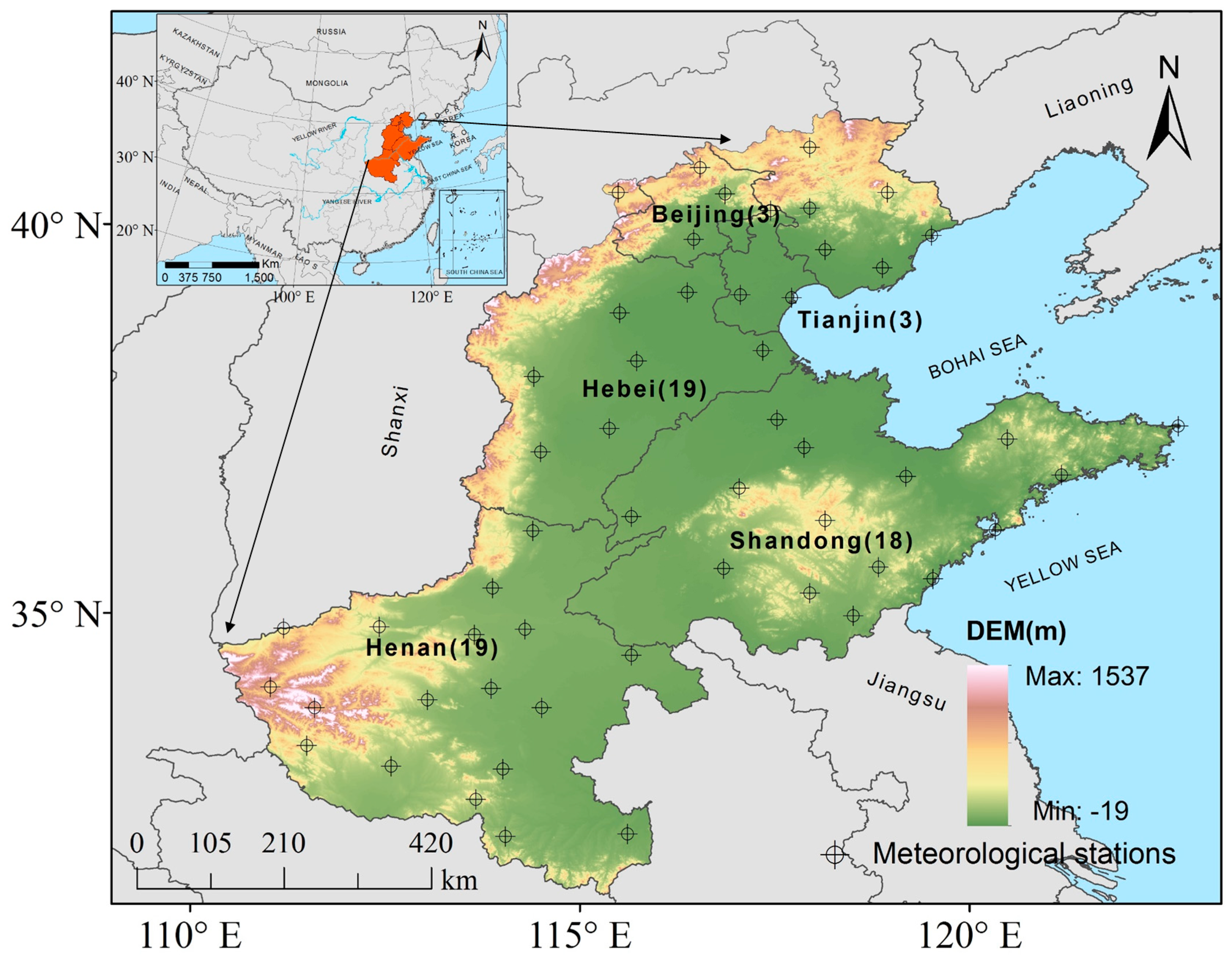
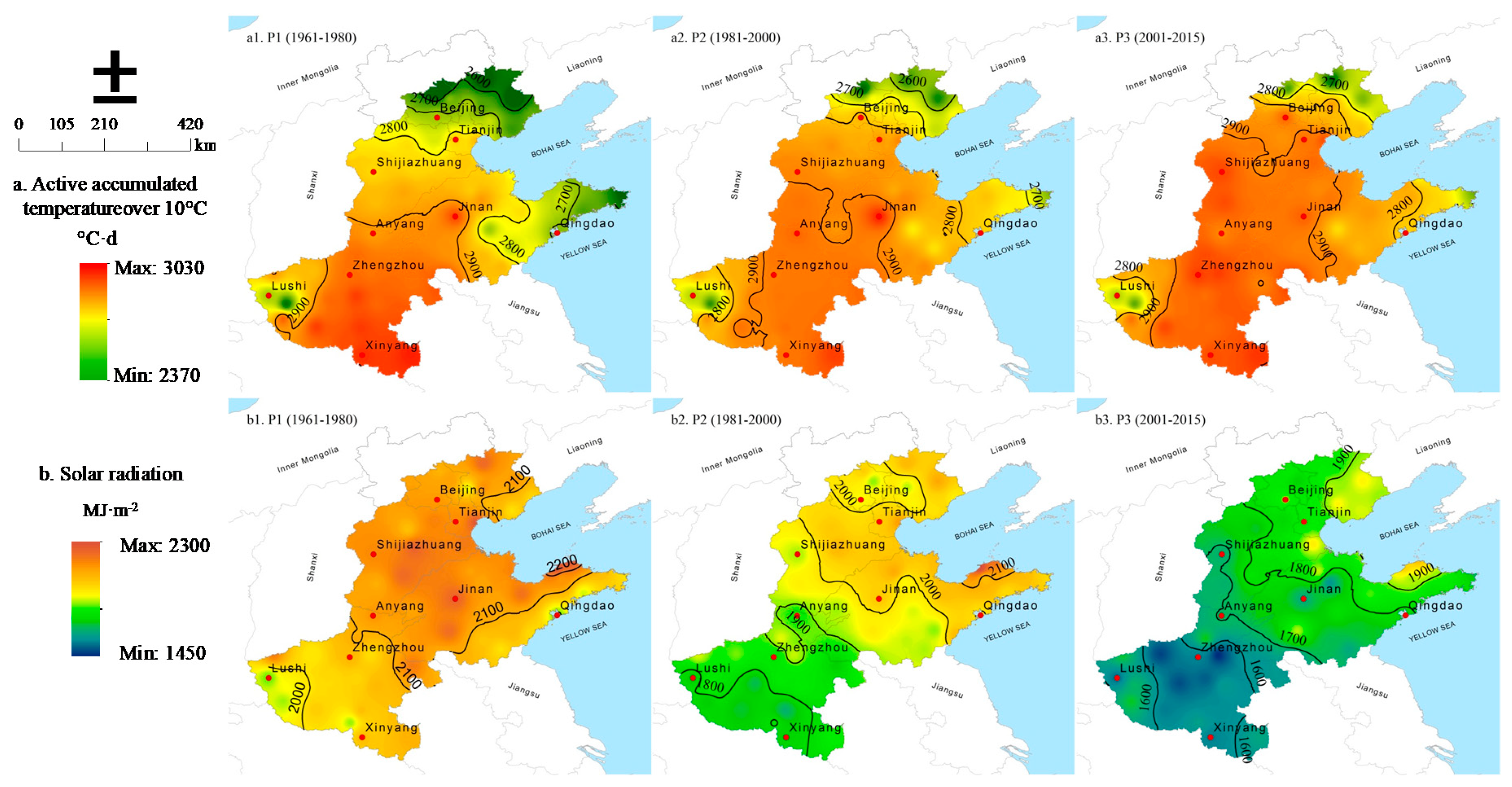
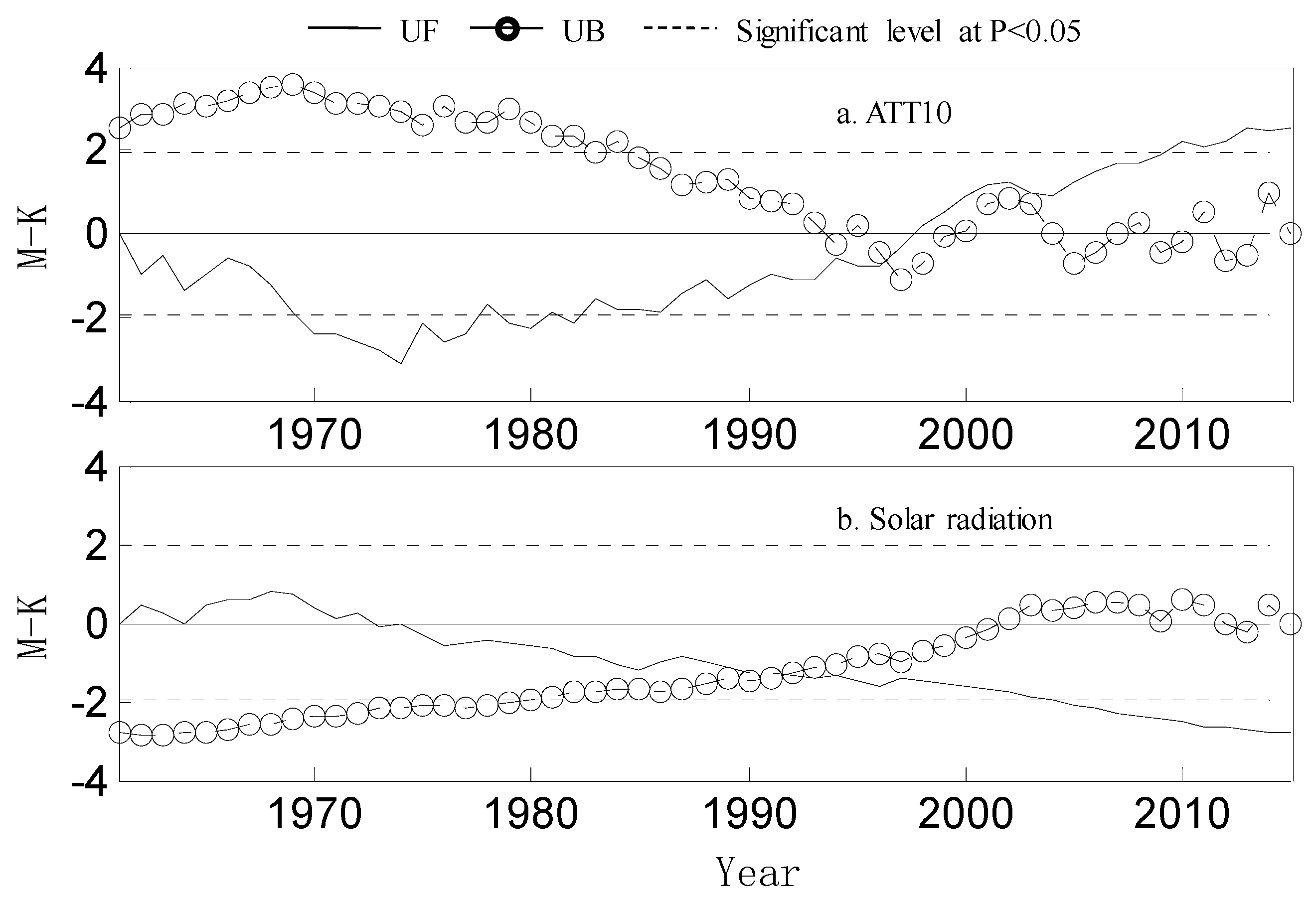


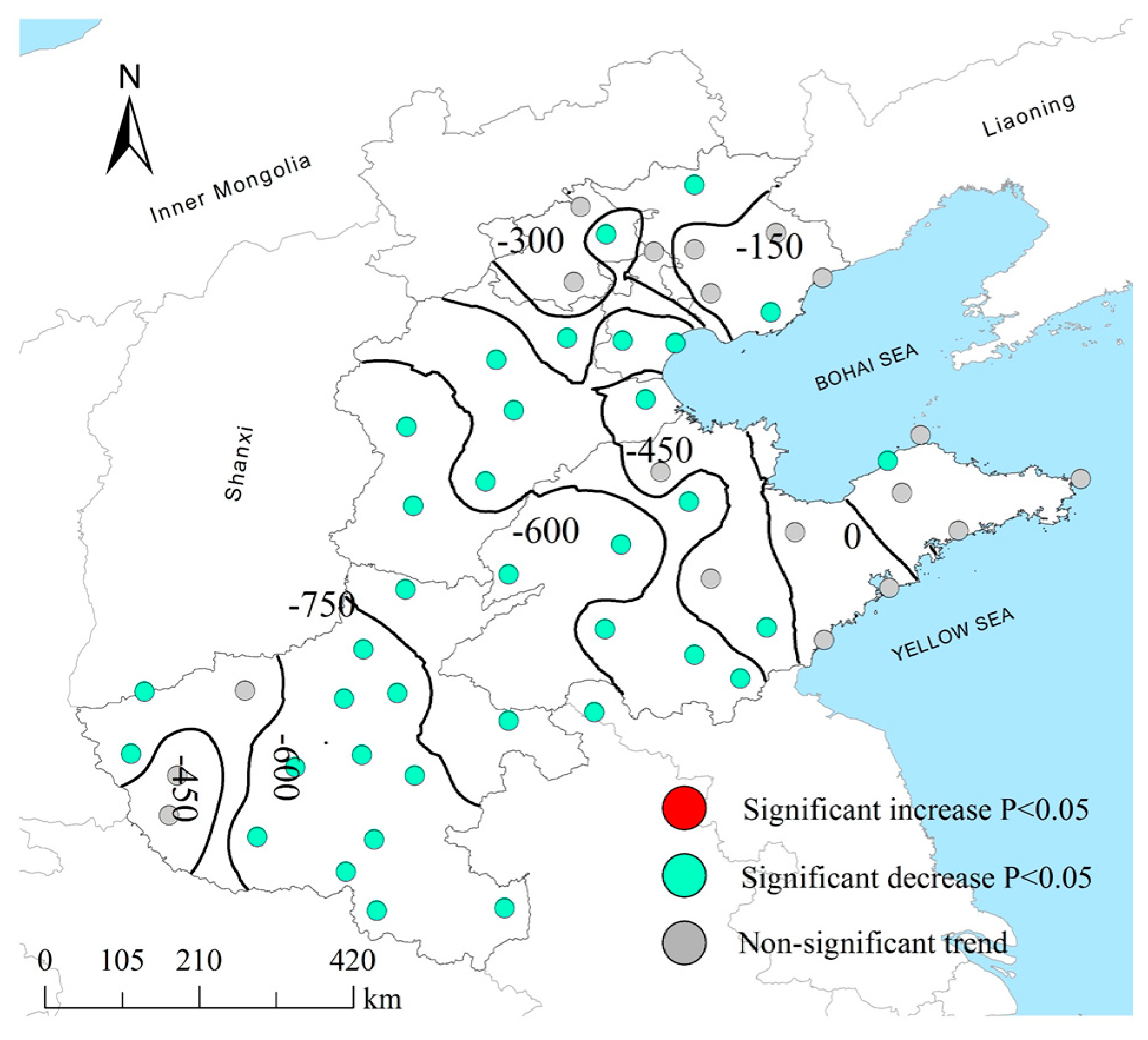
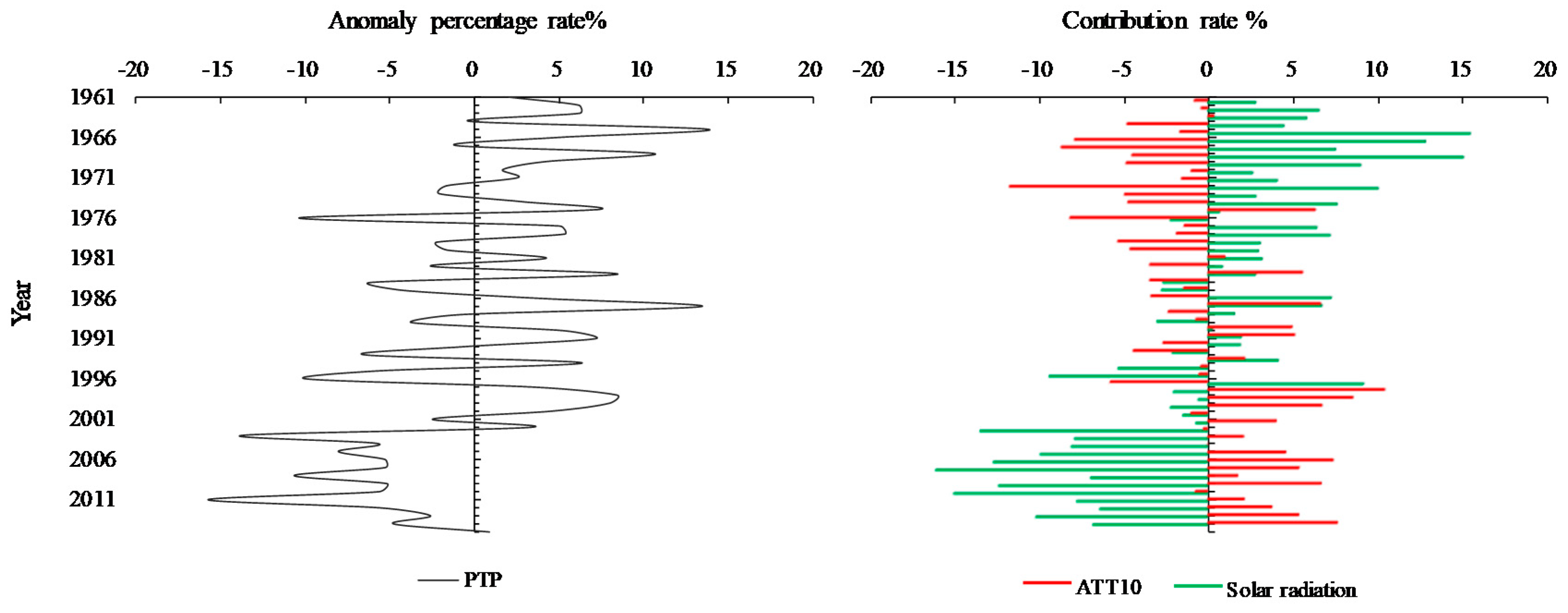
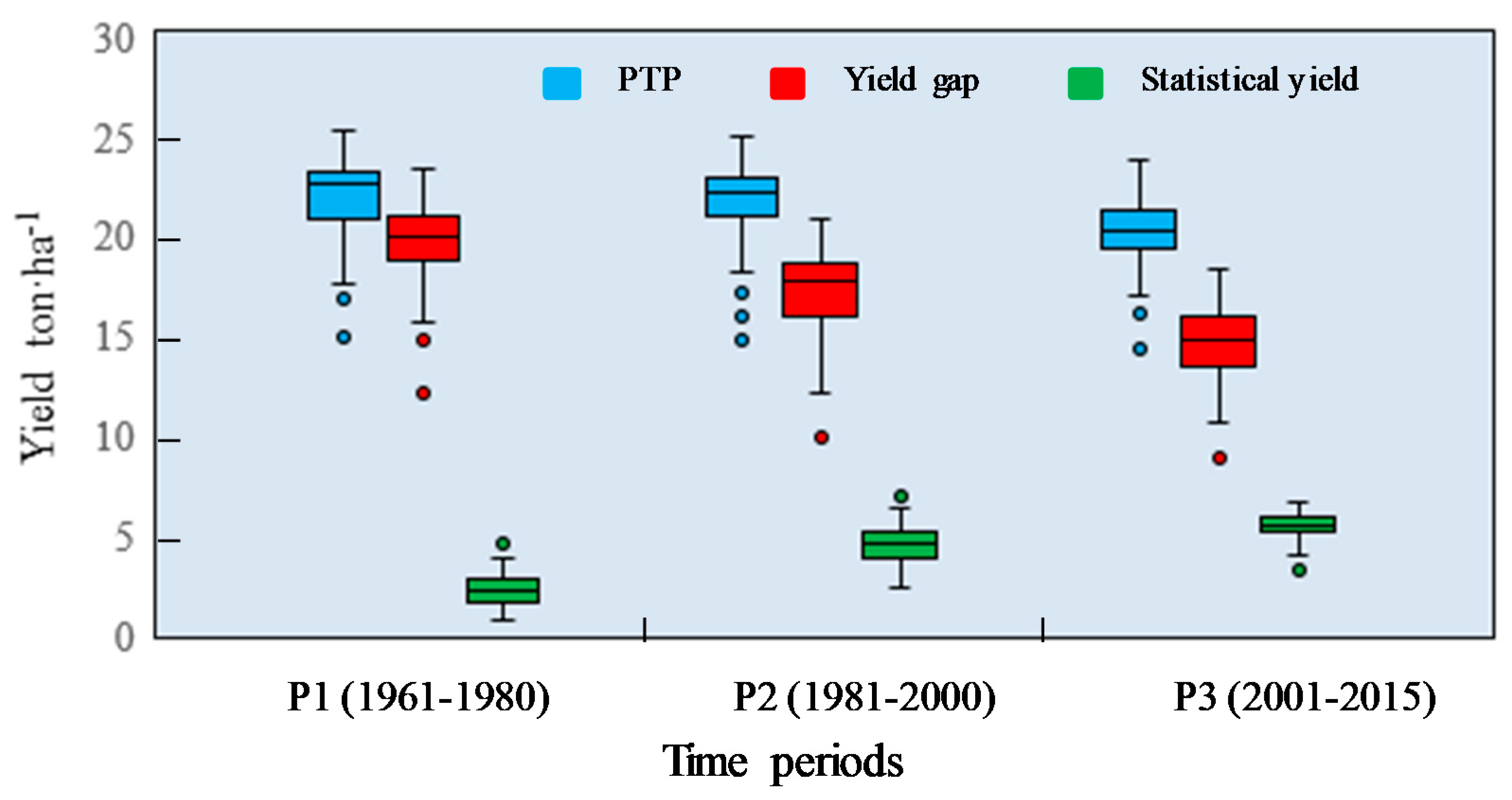
| Mean Temperature (°C) | Maximum Temperature (°C) | Minimum Temperature (°C) | Relative Humidity (%) | Precipitation (mm) | Wind Speed (m/s) | Sunshine Hours (h) | |
|---|---|---|---|---|---|---|---|
| Average value | 23.6 | 28.7 | 19.2 | 75.0 | 469.9 | 2.3 | 831.3 |
| Standard deviation | 1.1 | 1.3 | 1.4 | 3.7 | 78.3 | 0.7 | 79.8 |
| Stage | tmin | to | tmax |
|---|---|---|---|
| Initial (sowing–jointing) | 6 | 25 | 32 |
| Development (jointing–heading) | 10 | 27 | 35 |
| Middle (heading–start grain filling) | 15 | 27 | 34 |
| Late (start grain filling–maturity) | 15 | 23 | 32 |
| ATT10 °C·Day·Decade−1 | Solar Radiation MJ·m−2·Decade−1 | |
|---|---|---|
| Climate trend | 13.7 | −28.3 |
| Number of stations with significant increasing trend (P < 0.05) | 35 | 0 |
| Number of stations with significant decreasing trend (P < 0.05) | 0 | 55 |
© 2019 by the authors. Licensee MDPI, Basel, Switzerland. This article is an open access article distributed under the terms and conditions of the Creative Commons Attribution (CC BY) license (http://creativecommons.org/licenses/by/4.0/).
Share and Cite
Hu, Q.; Ma, X.; He, H.; Pan, F.; He, Q.; Huang, B.; Pan, X. Warming and Dimming: Interactive Impacts on Potential Summer Maize Yield in North China Plain. Sustainability 2019, 11, 2588. https://doi.org/10.3390/su11092588
Hu Q, Ma X, He H, Pan F, He Q, Huang B, Pan X. Warming and Dimming: Interactive Impacts on Potential Summer Maize Yield in North China Plain. Sustainability. 2019; 11(9):2588. https://doi.org/10.3390/su11092588
Chicago/Turabian StyleHu, Qi, Xueqing Ma, Huayun He, Feifei Pan, Qijin He, Binxiang Huang, and Xuebiao Pan. 2019. "Warming and Dimming: Interactive Impacts on Potential Summer Maize Yield in North China Plain" Sustainability 11, no. 9: 2588. https://doi.org/10.3390/su11092588
APA StyleHu, Q., Ma, X., He, H., Pan, F., He, Q., Huang, B., & Pan, X. (2019). Warming and Dimming: Interactive Impacts on Potential Summer Maize Yield in North China Plain. Sustainability, 11(9), 2588. https://doi.org/10.3390/su11092588







